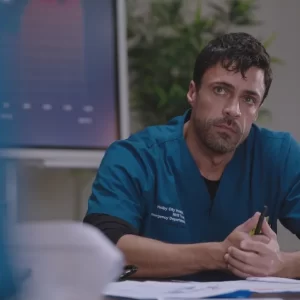Casualty is undergoing a transformation unlike anything in its 37-year history. And this time, the change doesn’t come in the form of a new doctor or a shocking patient case—it’s a full-on reboot of the show’s DNA.
Executive producer Jon Sen, who previously helmed EastEnders, has officially confirmed that the long-standing format of “accident of the week” is being scrapped. No more quirky household mishaps or implausible injuries. Instead, the series will now unfold in 12-episode narrative arcs—mini-seasons with a clear beginning, middle, and end. Each arc offers a tightly woven storyline designed to hook both loyal fans and new viewers who’ve felt left behind by the show’s endless continuity.
It’s a daring move. As Jon Sen bluntly admits, the “guess-the-accident” game that once brought quirky charm to Casualty has run its course. The future is darker, more intense, and more emotionally rooted. Viewers will now be dropped straight into the aftermath of severe trauma, and the narrative will focus entirely on how the medical team grapples with the consequences—professionally and personally.
But behind the scenes, not everyone is celebrating.
Sources close to production have revealed there was initial pushback from parts of the long-serving writing team, who were uncomfortable with the idea of sacrificing the show’s iconic structure. Several writers, accustomed to plotting high-concept “accidents” and fast-paced resolutions, reportedly expressed concern that focusing exclusively on in-hospital dynamics would make the series feel claustrophobic or even repetitive.
“There were real questions in the room,” one insider admitted. “People were asking—what happens when the adrenaline wears off? What if we lose the fun, the unpredictability?”

One of the most radical shifts is coming later this year: a fully improvised episode centered around four paramedics. No traditional script. Just actors reacting in real time to patient emergencies, mimicking the chaos of real-life ambulance services. It’s an experiment in raw, unscripted storytelling that will either land with powerful impact—or miss entirely. Jon Sen himself confessed he worried whether he’d “pushed it too far.”
Privately, some cast members voiced anxiety over being thrown into improv mode without the safety net of rehearsal or dialogue. One actor allegedly asked, “What happens if it just… doesn’t work? Will the audience forgive us—or crucify us?” And while the episode has since earned admiration from internal test screenings, it was a creative gamble that many feared could backfire and damage the show’s credibility.
Meanwhile, long-time fans are split. Online forums have erupted with debate—some viewers are thrilled by the shift toward serialized arcs, comparing the rebooted Casualty to prestige medical dramas like Grey’s Anatomy or The Good Doctor. Others worry that the show’s soul—its uniquely British balance of grit, compassion, and quirk—might be lost in the pursuit of modernity.
Beyond format changes, Casualty is also preparing for major emotional farewells. Fan favorites David Hide (Jason Durr) and Ethan Hardy (George Rainsford) are stepping away—at least for now. While these departures are described as “breaks,” their absence marks a significant emotional beat in the show’s current trajectory. Sen reassures fans that these characters are not being written off permanently, calling them “too beloved and too developed” to lose for good.
In the lead-up to the improvised special, current storylines are already diving into darker, more topical territory. Stevie finds herself the victim of a violent patient attack—an incident inspired by the increasing aggression NHS staff face in real life. Emotionally shattered, she turns to Marcus, beginning a psychologically coercive and toxic relationship that echoes real-world trauma and isolation. It’s raw, it’s personal—and far more complicated than anything Casualty has tackled in years.
But perhaps the most revolutionary shift lies in how Casualty is rethinking serial storytelling. No longer a never-ending stream of loosely connected subplots, the series is being broken into self-contained arcs—allowing viewers to jump in at specific points without needing a deep back catalog of context. The first arc, airing in January, centers on Dylan unraveling an abuse case. The second will introduce fresh-faced nurses navigating their first chaotic months in the ER.
One source from the story team described this new structure as “a mini-series within a series.” But with that clarity comes pressure. Writers are now required to think like filmmakers—balancing narrative beats, character arcs, and emotional payoff within tighter constraints.
And while the team has largely embraced the challenge, there’s a noticeable tension in how far the show is expected to push its realism. “There’s a line between authenticity and trauma porn,” one script editor warned. “We want it to feel real—but not like a punishment.”
Sen also teases potential crossovers with Holby City, which still commands deep affection among UK audiences. Sacha Levy’s cameo is only the beginning. With so many characters loved and missed, the door is wide open for more returns—perhaps even permanent ones.
And let’s not forget the shift in tone. Casualty is no longer interested in zany accidents or gimmicky setups. Instead, the focus is firmly on what happens inside the hospital—on the emotional, medical, and psychological unraveling that begins once patients arrive broken, bleeding, and desperate. The goal is authenticity, adrenaline, and heart—not cheap shocks.
In Jon Sen’s words, Casualty must remain Saturday night entertainment—but with truth at its core. “We’re not that show anymore,” he declares. “Now, it’s about the patient who comes in with their arm hanging off—and what that does to everyone in that room.”
As the show walks a tightrope between reinvention and nostalgia, one question looms large:
Will this bold new direction breathe new life into Casualty—or risk losing the very soul that’s kept it alive for nearly four decades?





